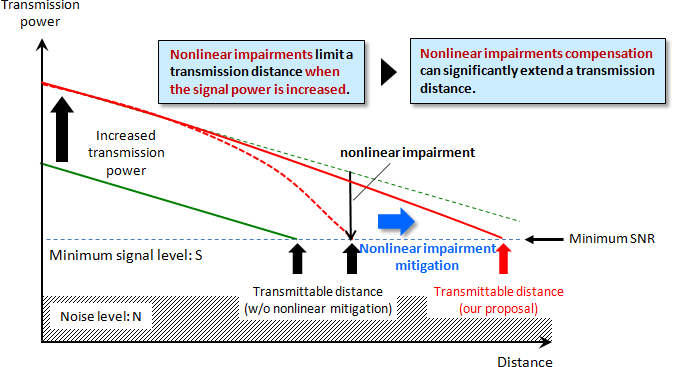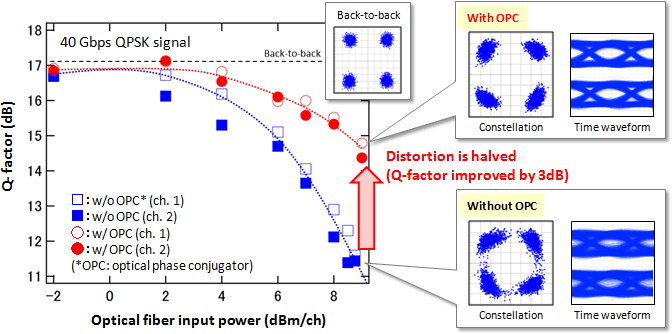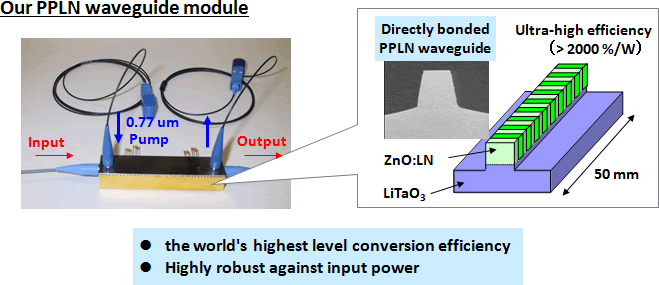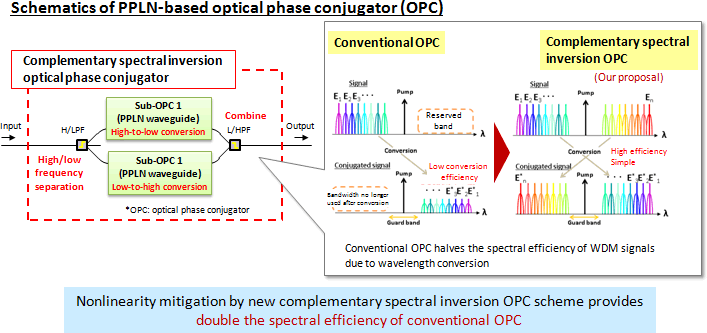Microsoft ends support for Internet Explorer on June 16, 2022.
We recommend using one of the browsers listed below.
- Microsoft Edge(Latest version)
- Mozilla Firefox(Latest version)
- Google Chrome(Latest version)
- Apple Safari(Latest version)
Please contact your browser provider for download and installation instructions.
October 1, 2015
High-density simultaneous compensation of distortion in wavelength-multiplexed signals using a time-reversal operation: World's first successful proof of principle
Nippon Telegraph and Telephone Corporation (Headquarters: Chiyoda-ku, Tokyo, President: Hiroo Unoura, referred to as NTT in the following) has developed a simple technique whereby transmission distances can be significantly increased with a new optical circuit that uses optical phase conjugation*1 to compensate the waveform distortion that limits the transmission distance when transmitting high-capacity optical signals, and has demonstrated this technique in the world's first proof of concept.
Optical phase conjugation is an optical technique that involves creating a time reversal wave that causes light to behave as if it is traveling backwards in time. When applied to optical fiber transmission, it can be used to simultaneously compensate the distortion of optical signal waveforms in multiple channels (wavelengths). NTT has just developed a new highly efficient optical phase conjugator that can compensate distortion in optical fibers without compromising their high transmission capacity, and has successfully achieved improvement of waveform distortion in optical signals (reducing the amount of distortion by half).
This technique can be implemented with less than one tenth the amount of signal processing required for the current practical technology of distortion compensation by electrical signal processing, and raises the possibility of high-capacity long-haul backbone networks that are more affordable and energy-efficient to support the future requirements of big data and ultra-high-definition TV.
This achievement was announced on September 30 (local time) at the European Conference on Optical Communication (ECOC2015) -- Europe's largest international conference on optical communication, which is being held in Valencia, Spain starting from September 27.
This research and development was achieved in part based on the results of the "R&D on Optical Signal Transmission and Amplification with Frequency/Phase precisely controlled carrier" funded by the National Institute of Information and Communications Technology (NICT), Japan.
1.Background of research
As broadband services expand due to the spread of technologies such as FTTH and smart phones, the communication traffic in Japan has increased tenfold over the last decade, and is expected to continue increasing in the future. To cope with this increased communication traffic, it is essential to increase the capacity of optical backbone networks using optical fibers. In recent years, progress has been made in the development of digital coherent technology*2 that provides optical transmission with greater efficiency by actively exploiting the properties of light waves (phase*3 and polarization*4). Practical high-capacity optical transmission systems that are capable of long-haul transmission using roughly 100 different wavelengths with a capacity of 100 Gbps per wavelength are already available, and further increases in capacity are continuing to be made [1].
Digital coherent technology achieves long-haul transmission by using electrical digital signal processing to compensate various forms of waveform distortion in a separate receiver circuit for each wavelength after optical fiber transmission. In the future, with further increases in capacity through the use of more frequency channels and the enhancement of transmission speed, the input power to the optical fibers will have to increase because a correspondingly higher SN (signal-to-noise) ratio*5 will be required. However, with high-power optical transmissions, the signal distortion in optical fibers (nonlinear impairment) has become a limiting factor of the transmission distance (Fig. 1).

2.A new approach to nonlinear impairment compensation using optical phase conjugation, and the issues thereof
In digital coherent technology, nonlinear impairment compensation can also be achieved to some extent and is already approaching the stage of practical use, but there is a trade-off with the increased scale of signal processing circuitry needed to improve the compensation performance (Fig. 2a). To accommodate future increases in the speed of signals and the number of wavelength channels, there is a need for technology that can transmit high-power optical signals by exploiting the full potential of optical fibers while reducing the burden of signal processing in digital coherent technology.
One method that has been previously investigated as a means of nonlinear impairment compensation without using electrical digital signal processing involves generating a time reversal wave by optical phase conjugation. In this technique, the waveform distortion that occurs during optical fiber transmission can in principle be undone as if playing a movie backwards. If optical phase conjugation is performed at a point in the middle of the optical fiber transmission path, then the waveform distortion incurred in the first half of the transmission path can be repaired in the second half (Fig. 2b). This allows optical fibers to transmit more powerful optical signals than before, and makes it possible to improve the SN ratio. It also offers the possibility of simultaneously processing multiple wavelength channels with a single optical phase conjugator, which is expected to greatly reduce the amount of digital signal processing. However, when conventional optical phase conjugation is performed, the optical signals convert to different signal channels (wavelengths) and take up twice the number of signal channels. As a result, the channel bandwidth that can be transmitted by an optical fiber decreases to less than half that of the conventional method, which has been a serious issue for application to high-capacity optical transmission.

3.Results of our research
NTT Network Innovation Laboratories and NTT Device Technology Laboratories have devised an optical phase conjugator consisting of a periodically poled lithium niobate (PPLN)*6 waveguide device that can perform optical phase conjugation with low noise and with the world's highest level of efficiency. Using this device, we have created a new optical circuit capable of optical phase conjugation without wastefully occupying wavelength channels. As a result, we have developed an optical phase conjugator that can compensate waveform distortion without impairing the high capacity of the optical fiber.
In fact, using the optical phase conjugator we developed, we have performed transmissions while compensating the distortion of optical signal waveforms in a QPSK signal with a channel capacity of 40 Gbps, and we have succeeded in reducing the waveform distortion of signals transmitted with high optical power by up to a half, compared with equipment that does not use an optical phase conjugator (Fig. 3). In this case, with regard to the signal processing of the optical transceiver circuit, we demonstrated that there was no need for digital signal processing to compensate for nonlinear impairment, and that the digital signal processing to compensate distortion caused by wavelength dispersion could be reduced to less than 1.5% of the processing needed by conventional systems. Unlike the method used for digital signal processing where it is necessary to compensate each signal channel, we have shown that the optical phase conjugation method for compensating distorted signal waveforms is able to process multiple wavelengths (approximately 100 channels) at a time. The proposed technique is therefore still compatible with digital coherent technology while reducing the amount of digital signal processing by at least a factor of ten.

4.Technical points
(1)Highly efficient PPLN waveguide device (Fig. 4)
To introduce an optical phase conjugator to the optical fiber transmission system requires a nonlinear optical device capable of realizing an optical phase conjugation at high efficiency. Based on advanced optical waveguide device fabrication process technology that has been cultivated at NTT over many years, we have developed a non-linear optical device consisting of a PPLN waveguide device that not only provides the world's highest level of conversion efficiency, but also has a high level of robustness against the intense pump light that is needed for conversion.
Fig. 4: High efficiency PPLN waveguide device
(2)Complementary spectral inversion optical phase conjugation technology (Fig. 5)
In the conventional optical phase conjugation method, it is necessary to reserve separate channels (wavelengths) for the signals before and after conversion, which has been a problem because it means that it is only possible to use half the optical fiber's transmittable bandwidth. To overcome this problem, we developed a new optical signal processing circuit that spatially separates signal channel bands of the longer-wavelength and shorter-wavelength sides of a wavelength multiplexed signal, and then uses a highly efficient PPLN waveguide device to perform optical phase conjugation on each of these signal channel bands. In this way we have achieved optical phase conjugation that can compensate the waveform of multiple wavelengths simultaneously without compromising the optical fiber's large capacity.
Fig. 5: Complementary spectral inversion and optical phase conjugation technology
5.Future prospects
In this experiment, we have developed a core technique for exploiting the latent potential of digital coherent technology. By making further developments in optical phase conjugation technology to make full use of the properties of light waves, and by working to combine this with digital coherent technology in order to achieve lower costs and lower power consumption, we will contribute to the realization of high-capacity long-haul backbone networks to support the development of broadband services in the future.
[Publication details]
T. Umeki, T. Kazama, H. Ono, Y. Miyamoto, and H. Takenouchi, "Spectrally Efficient Optical Phase Conjugation based on Complementary Spectral Inversion for Nonlinearity Mitigation," in 41st European Conference on Optical Communication (ECOC2015), Valencia, Spain Sept. 2015.
[Glossary]
-
Optical phase conjugation
Light has the same sort of wave-like properties as radio waves, and the timing of a wave's vibrations is called its phase. A wave in which the positive and negative phases have been reversed is called a phase conjugate wave, and the process of phase reversal is called optical phase conjugation. A phase conjugate wave is transmitted just as if it is traveling backwards in time, like a movie being played backwards, and is therefore sometimes called a "time reversal wave". -
Digital coherent technology
Conventional intensity modulation techniques by transmitting a signal with two intensity states (on and off) corresponding to the ones and zeroes of the data being transmitted. In digital coherent technology, multiple signal states are generated by using a polarized optical signal with two optical signals, or by modulating a combination of field amplitude and phase components of the electrical field of optical signal. In this situation, it is possible to perform optical transmission with higher efficiency and sensitivity than intensity modulation methods by supporting digital signals that convey multiple bits of information. -
Phase
Light has wave properties similar to radio waves. The timing of a wave's vibrations is called its phase. Since a wave vibrates periodically, its phase can vary in a range of between 0 and 360 degrees. Using this freedom, by assigning different phases (e.g., 0 and 180 degrees) to the ones and zeroes of digital data and detecting these phase differences at the receiving end, it is possible to achieve greater receiver sensitivity, longer transmission distances, and more efficient and higher capacity transmission than conventional on-off optical schemes. This sort of communication method is called phase modulation. -
Polarization
Like radio waves, light waves are able to vibrates in two separate directions (the X and Y axes). These independent axes are called polarizations. 3D movies often exploit this property to produce three-dimensional images by sending different information to the viewer's left and right eyes. In conventional optical communication, since it is difficult to stably detect the two polarization directions at the receiving end, it has not been possible to use just one polarization component. With digital coherent technology, the two independent polarization directions can be stably separated at the receiving end. This means that independent information can be transmitted in each polarization, enabling more efficient high-capacity communication. -
SN ratio (signal-to-noise ratio)
The ratio of the signal power needed to transmit information and the noise that degrades this signal. A higher SN ratio indicates that the transmission is less affected by noise, and that the signal is in good condition. -
Periodically poled lithium niobate (PPLN)
Lithium niobate (LiNbO3) is a crystalline material that exhibits nonlinear optical effects that allow light waves of different wavelengths to interact with each other. PPLN is an artificial crystal in which the orientation of positive and negative charges in the crystal is forcibly inverted with a fixed period inside the crystal by spontaneous polarization. With periodically poled lithium niobate, it is possible to achieve an overwhelmingly high nonlinear optical effect compared with the original lithium niobate crystal.
For further information, please contact:
Nippon Telegraph and Telephone Corporation
Science and Core Technology Laboratory Group, Public Relations
a-info@lab.ntt.co.jp
Information is current as of the date of issue of the individual press release.
Please be advised that information may be outdated after that point.
NTT STORY
WEB media that thinks about the future with NTT











